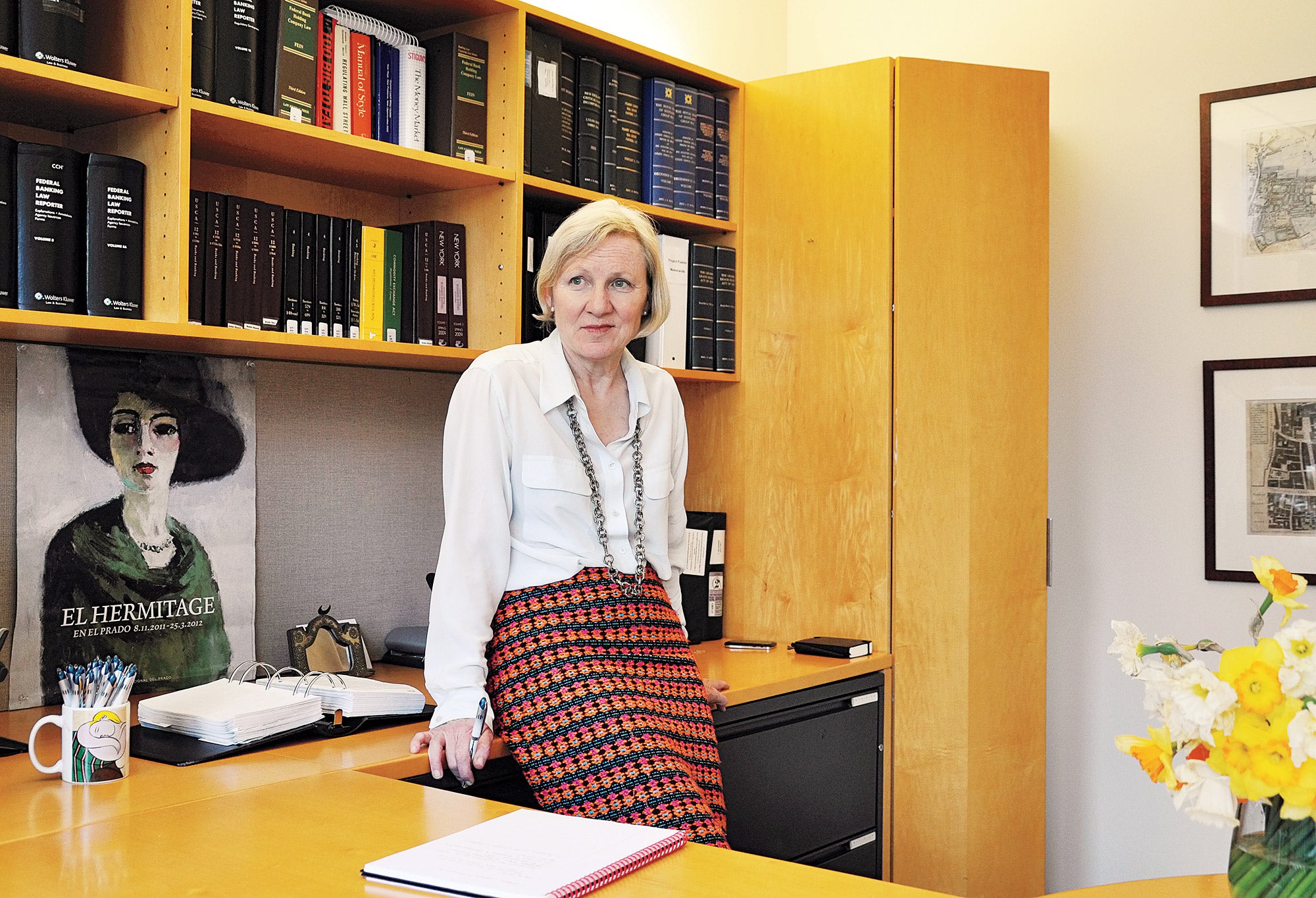In 20 years as a bank regulatory lawyer, Robin Maxwell ’85 has encountered nothing quite as complicated as the Volcker Rule, the 2010 financial overhaul law provision designed to limit risk-taking on Wall Street.
So when the five U.S. banking regulators approved the final version last December, Maxwell shut the door of her midtown Manhattan office, did her best to ignore the phone and emails, and started to read.
For three days, Maxwell pored over the 71-page rule and nearly 900-page preamble, trying to figure out what was different from an earlier version, which had attracted withering criticism on Wall Street.
“This was just a huge new piece of incredibly important regulation essentially coming down at once,” says Maxwell, who heads Linklaters’ U.S. financial regulation group. “It’s an interesting and challenging time.”
Three and a half years after President Barack Obama ’91 signed the Dodd-Frank Act into law, directing regulators to develop the Volcker Rule, banks finally had the final language detailing how regulators intended to limit banks’ ability to trade on their own money and invest in hedge funds.
But the work was just beginning for banking lawyers such as Maxwell, who estimates she has spent 90 percent of her time since December helping client banks figure out what the final rule means and how to comply with it.

The final rule’s release hasn’t ended the broader debate over whether the Volcker Rule goes too far—or not far enough—in trying to prevent another financial crisis.
Advocates of the rule—which was originally proposed by Paul Volcker, former chair of the Federal Reserve—argue that barring banks from making risky bets with their own money could help avoid future Wall Street bailouts.
“What will happen is the biggest firms in the country that are literally too dangerous to fail, that are backed by U.S. taxpayers, will not be engaging in the high-risk activities that threaten failure and bailouts,” says Dennis M. Kelleher ’87, president of Better Markets Inc., a Washington, D.C.-based nonprofit organization that advocates for stricter financial regulations. “It’s that simple.”
But critics, including Harvard Law School Professor Hal Scott, make the case that proprietary trading by banks didn’t cause the 2008 financial crisis and prohibiting it won’t necessarily prevent another one.
Nor, Scott says, is it easy to define the borderline between prohibited activity and what should remain permitted, such as placing trades to hedge risk or buying stocks and bonds for customers, known as market-making.

“The division between proprietary trading and market-making or proprietary hedging and hedging is inherently unclear,” says Scott, who testified against the Volcker Rule in his capacity as director of the Committee on Capital Markets Regulation, a financial industry-backed group. “These are judgment calls. You can’t define them in writing.”
While Scott argues that the exemptions weren’t broad enough, then Federal Reserve Board Governor Sarah Bloom Raskin ’86 voted against a proposed version of the Volcker Rule approved by the Fed because it wasn’t strict enough.
“The potential costs associated with permitting hedging and market-making within these exemptions still outweigh the benefits we as a society supposedly receive from permitting these capital-markets activities,” Raskin said in a 2012 speech. (She voted in favor of the final rule and has since been confirmed as the deputy secretary of the U.S. Treasury Department.)
The difficulty regulators faced in giving form to the “complicated statutory construct” laid out in the Dodd-Frank Act explains why it took so long to develop the final rule, according to HLS Professor Howell Jackson ’82. The rule, he says, included “lots of categories that were not well-defined.”
Complicating the task was the fact that responsibility for drafting the rule was shared by five agencies: the Federal Deposit Insurance Corp., the Securities and Exchange Commission, the Commodity Futures Trading Commission, the Board of Governors of the Federal Reserve System and the Office of the Comptroller of the Currency.
These “chronically underfunded” agencies, which were required to implement as many as 200 other major rules under Dodd-Frank, did the best they could, while working under the threat of court intervention and intense opposition from the financial services industry, according to HLS Professor John C. Coates.
One indication of Wall Street concern: the 17,000 public comment letters received after the proposed version of the rule was released in late 2011. And within days of the final vote in December 2013, the American Bankers Association filed suit challenging how the Volcker Rule treated certain debt instruments. In January, regulators announced banks could continue to hold these trust-preferred securities.
“It’s just a hard rule to write,” says Coates. “My guess will be people will think they did a pretty good job as benchmarked against what they set out to do.”
Already, it’s clear there are “a ton of interpretative questions” that remain unanswered even after the release of the final rule, such as what constitutes market-making or the types of funds that might be covered by the law, according to Maxwell. The multiplicity of regulators means that, unlike with newly promulgated regulations in the past, there isn’t one single entity that can provide a definitive answer.
Ralph Nader ’58 says he fears big banks and their lawyers will exploit the Volcker Rule’s “needless complexity” and regulators won’t have the resources to make sure banks comply with its requirements. The longtime consumer advocate wonders if there are “too many cooks spoiling the soup” and not enough auditors “to deal with the compliance.”
Even before the final rule was announced, banks had begun the process of shedding desks that engaged in proprietary trading. Going forward, the limitations laid out in the Volcker Rule mean large regulated banks are not likely to be the “dominant players” in new markets, Coates says.
“You’re going to have a fragmentation of information and of profit from being invested in trading the kinds of instruments that will emerge in the future,” says Coates. “Some of the higher-return activities will not be within the big banks, and therefore they’ll have a lower rate of return and it will make them less attractive for both employment and as a matter of return on capital.”
The Volcker Rule will cost large national banks as much as $4.3 billion and reduce the market value of their investments by 5.5 percent, according to an OCC study released in March. But large U.S. banks aren’t the only ones trying to figure out how they’re affected by the rule.
Foreign banks must determine how it impacts their operations in the U.S. and abroad, says Maxwell. And smaller regional banks are impacted by the restrictions on funds, says Margaret Tahyar, a partner in Davis Polk’s financial institutions group, who co-taught a winter-term course on bank regulation at HLS in 2013.
“The Volcker Rule is much more pervasive than people think,” Tahyar says.
Scott remains concerned that the rule is likely to make U.S. banks less competitive, particularly since European regulators seem unlikely to enact the same kind of prohibitions. What’s more, he worries that rather than eliminating risk, the new regulation will cause risky activities to migrate to less regulated corners of the financial system. “You have to question whether it’s better, even if you regard this activity as excessively risky, to keep it in a sector you highly regulate,” Scott says.
The only way to ensure that speculative risks that migrate outside the banking system due to the Volcker Rule don’t cause future financial crises is to regulate hedge funds and private-equity funds, Nader says. “So all in all, the principles behind it are good, the execution is limited.”
Nevertheless, says Jackson, the Volcker Rule could prove beneficial by helping curb “the culture of risk-taking that became part of the culture of commercial banking over time.” In his view, the rule could end up reducing the prominence of traders and making it less likely that bank leadership will be drawn from the trading community.
“That could have a very positive effect,” he says.
